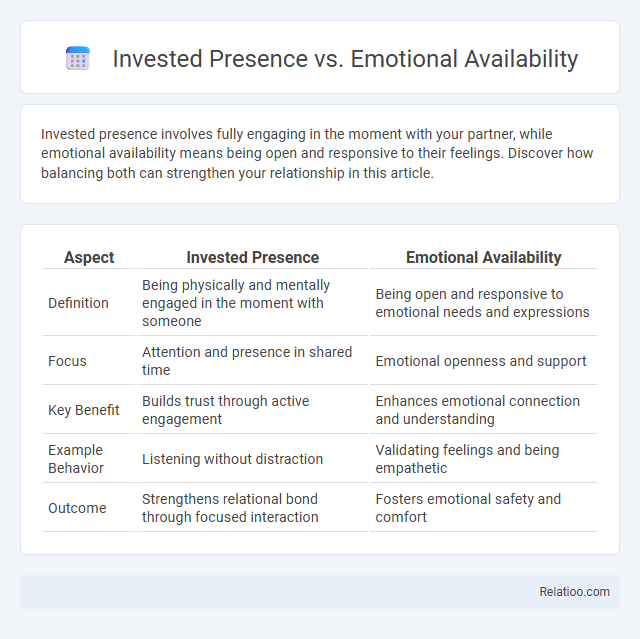Invested presence involves fully engaging in the moment with your partner, while emotional availability means being open and responsive to their feelings. Discover how balancing both can strengthen your relationship in this article.
Table of Comparison
| Aspect | Invested Presence | Emotional Availability |
|---|---|---|
| Definition | Being physically and mentally engaged in the moment with someone | Being open and responsive to emotional needs and expressions |
| Focus | Attention and presence in shared time | Emotional openness and support |
| Key Benefit | Builds trust through active engagement | Enhances emotional connection and understanding |
| Example Behavior | Listening without distraction | Validating feelings and being empathetic |
| Outcome | Strengthens relational bond through focused interaction | Fosters emotional safety and comfort |
Understanding Invested Presence
Invested presence refers to being fully engaged and attentive in interactions, prioritizing genuine connection over mere physical presence or emotional availability. Unlike emotional availability, which centers on openness to share feelings, invested presence demands active mental and emotional investment to deeply understand and respond. Understanding invested presence enhances relationships by fostering trust, empathy, and meaningful communication beyond superficial engagement.
Defining Emotional Availability
Emotional availability refers to your capacity to be present and responsive to emotions in relationships, providing a safe space for genuine connection. It differs from invested presence, which involves actively engaging and committing time and attention, by emphasizing openness to vulnerability and emotional attunement. Understanding emotional availability enhances your ability to nurture meaningful bonds beyond simply being physically or mentally engaged.
Key Differences Between Invested Presence and Emotional Availability
Invested presence involves actively engaging with your surroundings and commitments, demonstrating full attention and participation in moments or tasks. Emotional availability refers to your capacity to openly express and respond to feelings, fostering genuine connections and understanding with others. Your ability to balance invested presence with emotional availability enhances relationship depth by combining focused action with empathetic interaction.
Signs of Genuine Invested Presence
Genuine invested presence is characterized by focused attention, active listening, and responsive engagement, distinguishing it from mere emotional availability or superficial involvement. Signs include maintaining eye contact, validating your feelings, and consistently prioritizing your needs during interactions. This level of presence fosters trust and deep connection, as it reflects a true commitment beyond just being emotionally accessible.
Indicators of True Emotional Availability
True emotional availability is reflected through consistent invested presence, where your focus remains fully on the interaction without distractions or pretense. Key indicators include genuine eye contact, empathetic listening, and responsive body language that demonstrates understanding and connection. Emotional availability differs from mere physical presence by its depth of engagement and willingness to share and receive feelings openly and vulnerably.
Impact on Relationships: Invested Presence vs Emotional Availability
Invested presence involves actively engaging and dedicating attention to a partner, which strengthens trust and deepens relational bonds. Emotional availability refers to the capacity to openly share and process emotions, fostering intimacy and mutual understanding. Combining invested presence with emotional availability significantly enhances relationship quality by promoting both attentive support and emotional connection.
Benefits of Balancing Both Qualities
Balancing invested presence and emotional availability enhances your ability to form deeper, more meaningful connections by ensuring you are fully engaged and receptive to others' feelings. This harmony fosters trust and emotional security, improving communication and relationship satisfaction. By cultivating both qualities, you create a supportive environment where genuine understanding and empathy thrive.
Common Challenges in Achieving Both
Invested presence and emotional availability often face common challenges such as distractions, unresolved personal issues, and inconsistent communication patterns, which can impede your ability to fully engage in relationships. Balancing invested presence requires eliminating external interruptions and cultivating mindfulness, while emotional availability demands vulnerability and self-awareness to connect deeply with others. Overcoming these obstacles involves intentional effort to synchronize presence and emotional openness, fostering meaningful and authentic interactions.
Strategies to Enhance Invested Presence and Emotional Availability
Invested presence and emotional availability are critical components of healthy relationships that require intentional strategies for enhancement, such as active listening, mindfulness practices, and consistent emotional validation. Techniques like grounding exercises and focused attention foster invested presence by encouraging full engagement during interactions. To boost emotional availability, cultivating vulnerability through open communication and empathetic responses strengthens emotional connection and trust.
Cultivating Deeper Connections Through Mindful Engagement
Invested presence involves being fully attentive and engaged during interactions, fostering genuine connection by prioritizing your partner's emotions and needs. Emotional availability means openly sharing and responding to feelings, creating a safe space for vulnerability and mutual understanding. Cultivating deeper connections through mindful engagement requires balancing both invested presence and emotional availability, allowing your relationships to grow through authentic, empathetic communication.

Infographic: Invested Presence vs Emotional Availability
 relatioo.com
relatioo.com